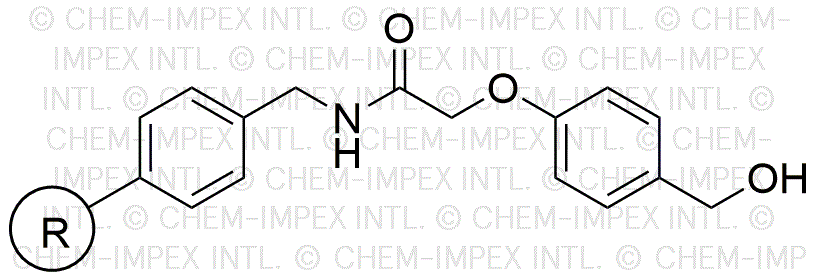HMPA-AM resin (0.3 - 0.6 mmol/g, 200 - 400 mesh) is widely utilized in research focused on:
- Chromatography: This resin is effective in separating and purifying various compounds, making it invaluable in analytical chemistry labs for high-performance liquid chromatography (HPLC).
- Environmental Remediation: It is used to capture and remove pollutants from water and soil, helping industries comply with environmental regulations and improve sustainability.
- Drug Delivery Systems: The resin can be incorporated into drug formulations to enhance the controlled release of medications, improving therapeutic efficacy in pharmaceutical applications.
- Polymer Science: HMPA-AM resin serves as a crosslinking agent in the synthesis of advanced polymers, contributing to the development of materials with enhanced mechanical properties.
- Biotechnology: It is utilized in the purification of biomolecules, such as proteins and nucleic acids, facilitating research and development in genetic engineering and molecular biology.
General Information
Properties
Safety and Regulations
Applications
HMPA-AM resin (0.3 - 0.6 mmol/g, 200 - 400 mesh) is widely utilized in research focused on:
- Chromatography: This resin is effective in separating and purifying various compounds, making it invaluable in analytical chemistry labs for high-performance liquid chromatography (HPLC).
- Environmental Remediation: It is used to capture and remove pollutants from water and soil, helping industries comply with environmental regulations and improve sustainability.
- Drug Delivery Systems: The resin can be incorporated into drug formulations to enhance the controlled release of medications, improving therapeutic efficacy in pharmaceutical applications.
- Polymer Science: HMPA-AM resin serves as a crosslinking agent in the synthesis of advanced polymers, contributing to the development of materials with enhanced mechanical properties.
- Biotechnology: It is utilized in the purification of biomolecules, such as proteins and nucleic acids, facilitating research and development in genetic engineering and molecular biology.
Documents
Safety Data Sheets (SDS)
The SDS provides comprehensive safety information on handling, storage, and disposal of the product.
Product Specification (PS)
The PS provides a comprehensive breakdown of the product’s properties, including chemical composition, physical state, purity, and storage requirements. It also details acceptable quality ranges and the product's intended applications.
Certificates of Analysis (COA)
Search for Certificates of Analysis (COA) by entering the products Lot Number. Lot and Batch Numbers can be found on a product’s label following the words ‘Lot’ or ‘Batch’.
*Catalog Number
*Lot Number
Certificates Of Origin (COO)
This COO confirms the country where the product was manufactured, and also details the materials and components used in it and whether it is derived from natural, synthetic, or other specific sources. This certificate may be required for customs, trade, and regulatory compliance.
*Catalog Number
*Lot Number
Safety Data Sheets (SDS)
The SDS provides comprehensive safety information on handling, storage, and disposal of the product.
DownloadProduct Specification (PS)
The PS provides a comprehensive breakdown of the product’s properties, including chemical composition, physical state, purity, and storage requirements. It also details acceptable quality ranges and the product's intended applications.
DownloadCertificates of Analysis (COA)
Search for Certificates of Analysis (COA) by entering the products Lot Number. Lot and Batch Numbers can be found on a product’s label following the words ‘Lot’ or ‘Batch’.
*Catalog Number
*Lot Number
Certificates Of Origin (COO)
This COO confirms the country where the product was manufactured, and also details the materials and components used in it and whether it is derived from natural, synthetic, or other specific sources. This certificate may be required for customs, trade, and regulatory compliance.

